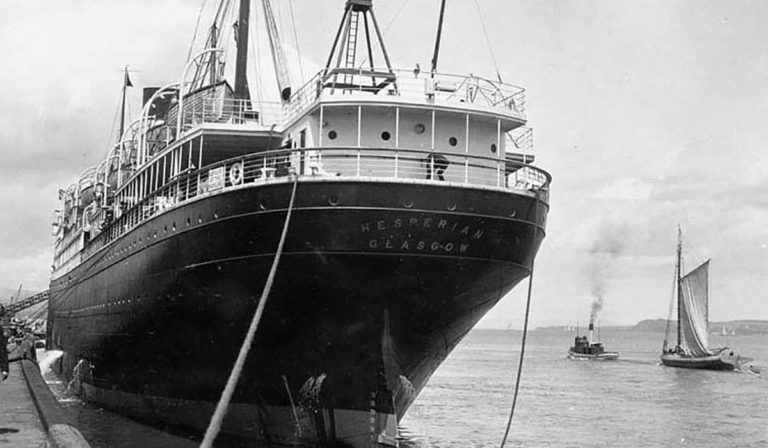My great–grandfather Harold Parker Ewart was a Merchant Mariner. His job took him all over the world and was extremely dangerous, particularly during wartime. Harold served in the merchant service throughout both World Wars and twice in his career was on board a merchant ship torpedoed by a German submarine.
Harold was born on 21 February 1892 in Carlisle, England, a border town in northwest England just south of Scotland. 1 He immigrated to the United States about 1916. 2 His wife, Mary Annie, and his three children, Grace, John, and my grandfather Harold, would join him in 1919. 3
Harold was a Merchant Mariner for both the United States and for the United Kingdom. The role of both the British Merchant Navy and the United States Merchant Marines is to move cargo and passengers within their own waters and between nations. Merchant Mariners also maintain and operate both private and government–owned merchant vessels. Contrary to popular belief, Merchant Mariners are not part of the military. However, during times of war they can be called upon to deliver military personnel and equipment. In the United States, the Coast Guard provides training and certification. 4
The merchant service suffered heavy losses during World Wars I and II due to German U-boat attacks. 5
World War I
During World War I, the Germans enacted a policy of unrestricted submarine warfare which meant that merchant seafarers and other civilians were at risk of attack from enemy ships. On 4 February 1915, Germany declared a war zone surrounding the United Kingdom and announced its intention to sink any vessels within British waters. Earlier in the war, U-boats followed “prize rules,” which called for a submarine to surface, search cargo, and allow passengers and crew to escape before sinking the ship. 6
On 7 May 1915, the RMS Lusitania was torpedoed without warning by a German submarine en route from Liverpool to New York. The luxury passenger ship sank in less than 18 minutes. 7 1,198 passengers and crew perished including 128 Americans. 8
The sinking sparked international outrage, particularly from the United States. To prevent the United States from entering the war, the Kaiser struck a deal with President Wilson and on 28 August 1915 formally announced that passenger ships would not be attacked without warning and U-boat captains would be responsible for the safety of those on board. 9
On 3 September 1915, the RMS Hesperian left Liverpool en route to Montreal. It was carrying cargo, passengers, and wounded Canadian soldiers. 10 Harold was part of the crew, a sixth–engineer. 11 The next evening, on the 4th of September, without warning, the German submarine U-20, under the command of Kapitänleutnant Walther Schwieger torpedoed the Hesperian off the coast of Ireland. In doing so, Schweiger violated an agreement that Germany made to the United States just a week earlier not to attack passenger ships without warning. 12 32 people, 10 passengers, and 22 crew members died. 13
A skeleton crew headed by Captain William Main stayed on board to try and save the vessel and tow it to shore, but the Hesperian sunk in the early morning hours of 6 September 1915. 14 Harold was one of those men and received an award from the President of the Board of Trade in appreciation of the British government. 15
World War II
In solidarity with Japan, after they attacked Pearl Harbor on 7 December 1941, the Axis powers declared war on the United States. 16 Just a month later, on 13 January 1942, Nazi Germany launched Operation Paukenschlag, or “Operation Drumbeat” as the allies would know it. It was one of the deadliest campaigns in World War II and its purpose was to defeat America on its own shores by attacking merchant ships and tankers. During the first half of 1942 more than 360 merchant ships and approximately 5,000, mostly merchant seamen were lost. 17 Mariners died at a rate of 1 in 26, during World War II, the highest of any group on the front lines. 18
On 23 December 1941, Kapitänleutnant Reinhard Hardegen, commander of U-123, left for the first phase of Operation Drumbeat. 19 After sinking the Cyclops and the Norness he entered New York Harbor on 15 January 1942. Due to the lack of merchant traffic, he made his way down the Atlantic coast facing little resistance from the United States. 20
On 19 January 1942, after sinking the City of Atlanta off Cape Hatteras, Hardegen had his sights set on the S.S. Malay. 21 The S.S. Malay, an oil tanker for the Gulf Oil Company, was en route from Philadelphia to Port Arthur, Texas, to take on a shipment of crude oil. Luckily the tanker was empty. 22
Harold, its chief engineer, must have had déjà vu. 23
“I had just come out of the engine room and an explosion knocked me down. I just kept lying down while the splinters dropped all around me.”
Skippered by John M. Dodge, the unarmed Malay, which carried a crew of 34, was shelled while leading an unescorted convoy. Kapitänleutnant Hardegen and his men fired ten shots, of which about six struck the Malay. The shelling killed one man, destroyed two lifeboats, and started a fire. Not realizing the size of the Malay, Hardegen decided not to use one of his two remaining torpedoes and instead left to chase other boats with the intention of sinking them. 24
While chasing down two other ships that got away, the crew of U–123 intercepted a distress message from the Malay revealing its size. Shocked at how large the ship was and recognizing its value, Hardengen planned to return and finish the job. Before heading back, he waited to attack another merchant vessel and torpedoed the Ciltvaira. 25
Meanwhile, the Scania came to assist the Malay and provided fire equipment. The crew got the fire under control and the ship underway. 26 When Kapitänleutnant Hardegen returned the crew of the Malay spotted the submarine and tried to get away. 27 Then Hardegen used his last remaining torpedo on the tanker and struck the starboard side tank. The crew abandoned the ship in lifeboats but one capsized, killing four men. 28 Harold was one of the 29 survivors.
Harold described his experience: “ I had just come out of the engine room and an explosion knocked me down. I just kept lying down while the splinters dropped all around me.” 29
Unlike the freighters City of Atlanta and Ciltvaira, the S.S. Malay did not sink. 30 The severely damaged Malay made it back to port on its own. 31 Forty-six merchant seamen died that night. 32
After hearing that her husband barely escaped with his life, Harold’s wife Mary Annie took the news in stride saying “It does no good to worry”. Saying she was used to sub-attacks, she recalled Harold’s experience on the Hesperian in 1915 and how he escaped uninjured and assisted in the aid of others. “You know, you get used to it”. 33
By the end of the war, 733 American cargo ships and 8,651 mariners died in dangerous waters. 34 Of those who were killed, 84 percent were listed as ”missing in action.” 35
A life–long mariner, Harold died on 23 January 1947 in the U.S. Marine Hospital in Staten Island, New York, of a heart ailment. 36 That same day, his son Harold (my grandfather), also a mariner, entered Kings County Hospital in Brooklyn where he would die 24 days later of tuberculosis at age 31. 37 They are both buried at Evergreens Cemetery in Queens, New York. 38

